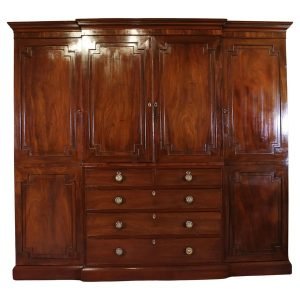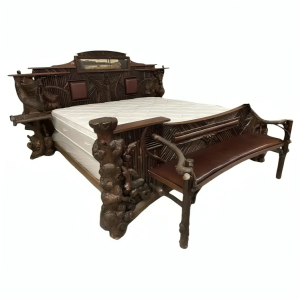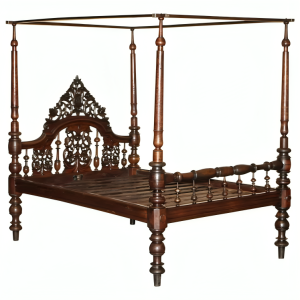Impressive Antique sissoo wood Anglo-Indian four poster bed
An impressive sissoo wood Anglo-Indian four poster bed, of rectangular form with a central openwork cresting, and splat, showing a naïve carving of the Coat of Arms of Great Britain, the lion and unicorn holding flags and flanking a Royal crown above an oval, all within floral scrolls and leaves, with turned spindles in the foot and head boards and barley twist bed posts, with the original steel winding key. .
Circa 1840.
R38,500.00
Impressive Antique sissoo wood Anglo-Indian four poster bed
An impressive sissoo wood Anglo-Indian four poster bed, of rectangular form with a central openwork cresting, and splat, showing a naïve carving of the Coat of Arms of Great Britain, the lion and unicorn holding flags and flanking a Royal crown above an oval, all within floral scrolls and leaves, with turned spindles in the foot and head boards and barley twist bed posts, with the original steel winding key. .
Circa 1840.
R38,500.00
An impressive sissoo wood Anglo-Indian four poster bed, of rectangular form with a central openwork cresting, and splat, showing a naïve carving of the Coat of Arms of Great Britain, the lion and unicorn holding flags and flanking a Royal crown above an oval, all within floral scrolls and leaves, with turned spindles in the foot and head boards and barley twist bed posts, with the original steel winding key. .
Circa 1840.
R38,500.00
Description:
The style of these beds dates from 1840 until 1947 (until Indian Independence).
They were constructed for the British military and their families in India and designed to collapse and be transported easily while on campaign or to their summerhouses in the hills.
The size, style, and quality of the bed depicted the status of the occupier and were made from the finest wood, usually mahogany, teak, or sissoo wood (a member of the rosewood family).
Teak and sissoo wood were used extensively because they only expanded and contracted minimally in extreme temperatures and humidity. In addition, they were resistant to woodworms, termites, and the occasional splash of seawater.
Dimensions
Height: 100 in (254 cm)
Width: 91.5 in. (232.41 cm)
Depth: 72 in. (182.88 cm)
Description:
The style of these beds dates from 1840 until 1947 (until Indian Independence).
They were constructed for the British military and their families in India and designed to collapse and be transported easily while on campaign or to their summerhouses in the hills.
The size, style, and quality of the bed depicted the status of the occupier and were made from the finest wood, usually mahogany, teak, or sissoo wood (a member of the rosewood family).
Teak and sissoo wood were used extensively because they only expanded and contracted minimally in extreme temperatures and humidity. In addition, they were resistant to woodworms, termites, and the occasional splash of seawater.
Dimensions
Height: 100 in (254 cm)
Width: 91.5 in. (232.41 cm)
Depth: 72 in. (182.88 cm)











